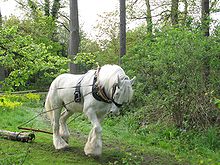


A swingletree (British Isles) or singletree (North America) is a small wooden or metal bar behind a harnessed horse. It is used to balance the pull of a draught horse or other draught animal when pulling a vehicle. It is a kind of whippletree, and the term is also used sometimes for other whippletrees.[1]: 261 [2]: 188
It is a horizontal bar, attached or suspended in the middle, and able to hinge fore-and-aft in a horizontal plane. The traces (the straps by which the animal pulls) attach to its ends, and the vehicle is pulled from its middle.
The centre of the swingletree may be bolted directly to the body of the vehicle, this bolt pulling the vehicle along. Alternatively it may hang loosely by a chain or strap from the body of the vehicle, and in this case the pull is taken by chains from the centre of the bar to the ends of the axle.
The action of a swingletree is to balance the pull from alternate shoulders as the animal walks. It is used especially when the animal is in a breastcollar harness, because this can easily rub the shoulders if the pull is uneven. It is needed less for an animal in a horse collar, as the pull does not pass over the shoulders in the same way. For this reason heavier vehicles may have no swingletree, as they are normally pulled with a horse collar.[1]: 261
See also[edit]
- Breastcollar
- Draft horse
- Draught animal
- Horse collar
- Horse harness
- Horse-drawn vehicles
- Whippletree (mechanism)
Well, that’s interesting to know that Psilotum nudum are known as whisk ferns. Psilotum nudum is the commoner species of the two. While the P. flaccidum is a rare species and is found in the tropical islands. Both the species are usually epiphytic in habit and grow upon tree ferns. These species may also be terrestrial and grow in humus or in the crevices of the rocks.
View the detailed Guide of Psilotum nudum: Detailed Study Of Psilotum Nudum (Whisk Fern), Classification, Anatomy, Reproduction